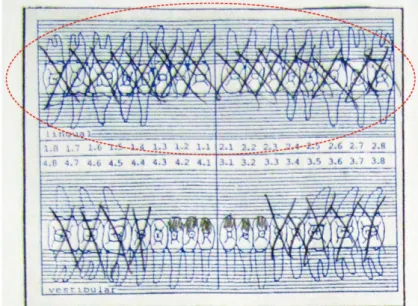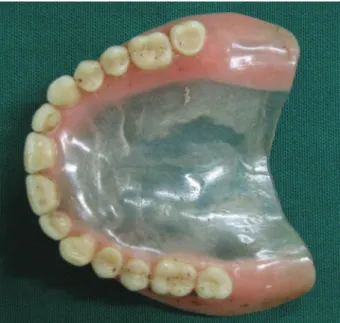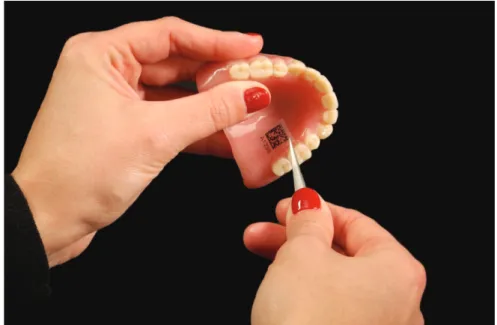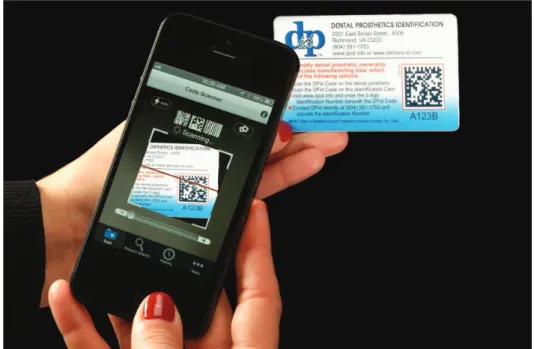Abstract
Submitted: April 1, 2016
Modiication: July 21, 2016 Accepted: August 30, 2016
A forensic identiication case
and DPid - can it be a useful tool?
Objective: The aim of this study was to show DPid as an important tool of potential application to solve cases with dental prosthesis, such as the forensic case reported, in which a skull, denture and dental records were
received for analysis. Material and Methods: Human identiication is still challenging in various circumstances and Dental Prosthetics Identiication
(DPid) stores the patient’s name and prosthesis information and provides
access through an embedded code in dental prosthesis or an identiication
card. All of this information is digitally stored on servers accessible only by dentists, laboratory technicians and patients with their own level of secure access. DPid provides a complete single-source list of all dental prosthesis features (materials and components) under complete and secure
documentation used for clinical follow-up and for human identiication. Results
and Conclusion: If DPid tool was present in this forensic case, it could have
been solved without requirement of DNA exam, which conirmed the dental
comparison of antemortem and postmortem records, and concluded the case
as a positive identiication.
Keywords: Forensic dentistry. Forensic anthropology. Denture
identiication marking. Dental prosthesis. Dentures. Cristhiane Leão de QUEIROZ1
Ellen Marie BOSTOCK2
Carlos Ferreira SANTOS3
Marco Aurélio GUIMARÃES4
Ricardo Henrique Alves da SILVA1
1Universidade de São Paulo, Faculdade de Odontologia de Ribeirão Preto, Departamento de Estomatologia, Saúde Coletiva e Odontologia Legal, Ribeirão Preto, SP, Brasil.
2Reynolds Community College, Richmond, VA, USA.
3Universidade de São Paulo, Faculdade de Odontologia de Bauru, Departamento de Ciências Biológicas, Bauru, SP, Brasil.
4Universidade de São Paulo, Faculdade de Medicina de Ribeirão Preto, Departamento de Patologia e Medicina Legal, Ribeirão Preto, SP, Brasil.
Introduction
Crime rate, terrorism, wars, mass disasters, road
trafic accidents and dreadful diseases have increased2.
Moreover, natural or man-made disasters present a different set of circumstances and, consequently,
each event results in new challenges for identiication
teams18. The identity of the deceased, assailant, or
the cause of death becomes important as the core of various investigations2.
Resilience of the dental structures to postmortem
assault, denture labeling, and teeth as a source of DNA
contribute to make identiication successful. Dental identiication is widely used, not only in the single
fatality situation, but also in mass fatality incidents and cases of missing persons9,22.
New technologies have been developed to make it faster and more effective and different disaster victim
identiication (DVI) protocols have been evaluated and
improved. The postmortem (PM) and antemortem
(AM) data are entered into a computer database that will ultimately search for best possible matches18.
Denture may demonstrate certain features that
can assist in the identiication such as old or recent
repairs, areas of relief, soft linings, material used, or a particular tooth type and arrangement. If a denture wearer was involved in an accident, crime, or mass disaster, it would be invaluable if the denture was labeled. The marker should ideally withstand most conditions, be acceptable to the patient, not weaken the denture, and be easy and cheap to produce and
give a positive identiication20.
The aim of this study was to show DPid as an
important tool of potential application to solve cases with dental prosthesis, such as the forensic case in which skull, denture, and dental records were received for analysis.
Case Report
A skull, complete bones, and a denture were found in a crime scene and they were referred to the
Center of Legal Medicine of Ribeirão Preto, University of São Paulo, for anthropological and dental analysis
at the Laboratory of Forensic Anthropology. The skull and complete bones presented the following anthropological information: male, interbred (white + black), predominantly black appearance, age range between 38 and 57 years (average 48 years), height between 1.68 m and 1.80 m. Skull and denture were sent to maxilla and mandible exams, dental prosthesis exam, radiographs, charts, photos, antemortem
information analysis as well as antemortem and
postmortem information comparison.
In intraoral clinical examination, absence of any dental element in maxilla and upper denture presence were observed. Canines, central and lateral
incisors, and the right irst premolar were present in
the mandible. Additionally, dental records and three periapical radiographs from the suspect’s family were received. Coincidence was found between points in dental records produced antemortem and the
postmortem analysis (Figures 1, 2, 3, 4, 5 and 6). Therefore, identification from antemortem
and postmortem dental records with consistent
characteristics was deined, if DPid tool was present
in this forensic case, it could have been solved without a requirement of DNA exam by the law enforcement
agencies, which conirmed the dental comparison and concluded the case as a positive identiication.
Discussion
Identification methods must be scientifically
sound, reliable, applicable under ield conditions, and
capable of being implemented within a reasonable period of time. The primary and most reliable means
of identiication are ingerprint analysis, comparative
dental analysis, and DNA analysis10.
The positive identiication of skeletal remains by
individual dental parameters is one of the objectives of criminal investigation. Intervention of Forensic Dentistry in some circumstances may represent
the only way to obtain a positive identiication of unidentiied bodies.
Human identification in Forensic Dentistry is performed through comparative and reconstructive
analysis. Identiication allows determining several
parameters of forensic interest: specimen, population
afinity, sex, age, height, and individualization factors. Forensic Dentistry is one of the most important ields in human identiication, because teeth have less
variability in the chronology of events in terms of the reconstructive way. On the other side, in comparative terms, this area is also important, because of the
individualization factors: positive identiication in
Figure 3- Skull referred to the Center of Legal Medicine of Ribeirão Preto, University of São Paulo, for anthropological and forensic
dentistry analysis at the Laboratory of Forensic Anthropology. Completely edentulous maxilla is highlighted (postmortem)
individual cases and in mass disasters17.
Body Identiication guidelines establishes some
criteria such as collection and preservation of
postmortem dental evidence: the remains – examination procedures; photography; the postmortem dental record: dental examination; narrative description and nomenclature; dental impressions; dental radiology; comparison of antemortem and postmortem evidence
– dental features useful in identiication; categories and terminology for body identiication – positive
identification; possible identification; insufficient evidence; exclusion1. These criteria were followed in
the present case, in which dental positive identiication
was achieved before DNA exam.
Marking or labeling of dental prosthesis, primarily
of dentures, for ownership identiication has been
occurring for years. Although there are several denture marking methods (engraving, scribing, writing,
and inclusion)4,15,the most challenging criterion is
the ability to survive a common range of chemical
and thermal insults with the exception of ire21. In
addition, these methods include variations of criteria; for instance, but not limited to, the prosthesis should not be weakened by the marking method and should be cosmetically acceptable. However, with increased
globalization, and especially the patients’ ability to
relocate around the world, two key elements should also be considered: security and technology.
The most commonly used form of ownership
identiication is inclusion or embedding the patient’s name or other personal identiier into the prosthesis.
This is the easiest and least expensive approach; however, it provides no level of personal security or
background information. For example, in the United States of America, ownership identiication is typically
done by embedding the patient’s name and/or Social Security Number (SSN) into the prosthesis7. A SSN
is a 9-digit number assigned to each citizen with
the original intent to monitor work history, but it
has since become a primary identiication source.
Displaying the patient’s name and/or SSN poses a considerable personal security risk because one in every 10 American consumers12 and approximately
11% of people over the age of 65 years have their identity stolen19.
In recent years, techniques using newer technologies with a higher level of security have been introduced
such as microdots, Radio Frequency Transponder (RFID) chips14,16,and memory card11. Unfortunately,
the cost associated with these technologies, both
in the item to be embedded and the specialized
reader/scanner necessary to extract the information, prohibits them from being broadly accepted by dental professionals.
Dental Prosthetics Identiication (DPid) provides a
Figure 4- Upper denture referred to the Center of Legal Medicine
of Ribeirão Preto, University of São Paulo, for anthropological and forensic dentistry analysis at the Laboratory of Forensic Anthropology (postmortem)
Figure 5- Amalgam restoration on the lower right irst premolar and dental attrition on the incisal borders of the lower canines as well as
viable alternative/solution to ownership identiication
using readily available and inexpensive technology in addition to providing a high level of personal security. The DPid system uses both an embedded code (Figure 7)6 and an identiication card (displaying
the same code) (Figure 8)6 providing an alternative
means of accessing patient identification and
prosthetic information. The identiication card may
also appeal to patients who wish not to have a code embedded in their prosthesis or if their prosthesis is not physically capable of having a code embedded such as a crown or a bridge. Also, because the code and 5-digit alpha/numeric number are associated, they are interchangeable. Then, if the prosthesis is physically too small to accept a code or the patient is not interested in having a code embedded into the
prosthesis, the smaller less obtrusive identiication
number may be used in its place.
DPid system randomly generates a unique 2D Data Matrix Code associated with a 5-digit alpha/numeric number for each patient. DPid code may be scanned using either a smartphone (Figures 8 and 9)6 or a tablet
equipped with a 2D Code Reader App (typically free)
or by logging onto the DPid website and entering the patient’s 5-digit alpha/numeric number.
Access to a patient’s identiication and prosthetic
information can only be gained by entering a password. However, if a patient is a resident at a nursing home or similar care facility, the password requirement may be omitted with the patient’s consent. All patient data are encrypted and stored on secure dedicated servers and are available only to dentists, laboratory technicians, and patients, each with their own level of secure access.
DPid system has two secure levels with Tier 1
including: the patient’s irst, middle, and last names;
all essential data listed on the Dental Prosthetic Categories to manufacture, repair, or remanufacture of the dental prosthesis including photographs and
case notes; speciic listing of U.S. Food and Drug
Administration Class II Dental Medical Device codes and numbers5,23; manufacture date; manufacturing
point-of-origin; dental laboratory business name, address, phone, e-mail, contact person; if the dental
laboratory is a Certiied Dental Laboratory Technician (CDT) on staff, Certiied Dental Laboratory (CDL), Dental Appliance Manufacturer’s Audit System Certiied Laboratory (DAMAS), or a U.S. State-Registered Dental
Laboratory; dentist business name, address, phone, e-mail, dentist name, and dentist license number;
Figure 6- Amalgam restoration on the lower right irst premolar
and dental attrition on the incisal borders of the lower canines as well as central and lateral incisors (postmortem)
notiication of pertinent health information (Tier 2)
about the patient’s dental well-being regarding the manufacturing materials or the procedure of inserting the dental prosthetic.
All dental prosthesis, removable or ixed, can
be identified with DPid system. Therefore, if a patient needs to have the prosthesis repaired or remanufactured, the laboratory technician can rapidly access all the necessary information via the embedded
code or identiication card. All information is entered in
“real-time”, in such a way the dentist and laboratory technician can access the patient’s information and
see the exact same data including materials and components, photographs, and case notes. If the dentist uploads photographs of the patient’s existing condition, the laboratory technician can see the condition of the patient’s existing dentition and what the dentist is proposing as a solution.
Dental professionals using the DPid system can be trained on how to enter and access data. For others who do not need this information, the DPid code will, in most cases, remain undetectable, as intended for the patient’s aesthetics and privacy. However, First
Responders (Fire and/or Emergency Medical Services)
Figure 8- DPid code scanned using a smartphone in an identiication card6
along with Forensics Experts who arrive on the scene to a nonresponsive or deceased person will follow speciic
processes and procedures in determining the identity of the person, which may include accessing removable
dental prosthetics. Under these circumstances, First Responders are typically trained and equipped with
smartphones or electronic tablets to log critical events, vitals, medications, actions, and logs. Because of this
training, a First Responder should recognize the DPid
code as a scan image and have a basic understanding of how it works. When contacted, DPid has processes
and procedures in place to assist First Responders in
emergency situations.
Regarding Forensic Dentistry, timely access to patient identiication and current dental records can be
crucial. Thus, marked dental prostheses (full and partial dentures, mouth guards, and removal orthodontic
appliances) would lead to rapid identiication in the
event of accidents and disasters8. Having access to
the patient’s dental prosthetic history and progression of prosthetic applications, such as crown, bridge, denture, attachment with implants, would further confirm identification, in addition to supporting photographs and case notes. The ability to have access to this information from anywhere around the world via the internet or mobile telecommunications technology would reduce valuable time and assets in the investigation process.
There are further complications with the purging of patient dental records. Archiving of patient information
varies between countries, considering that the U.S.A.
typically maintains records for six years3, while in Brazil
the dental records should be archived throughout the patient’s life13. Unfortunately, once the patient’s ile is
purged, there is no longer a record that can link the prosthesis to a patient. DPid digitally and securely stores dental prosthesis information archived and makes it accessible for patient’s lifetime.
Conclusions
Dental comparative analysis is one of the main human identification methods through individual
dental parameters that help in a positive identiication of unidentiied bodies. Forensic cases with dental
prosthesis presence can easily achieve positive
identiication if there is an identiication system,
embedded in the prosthesis. So, in situations as
the case presented, DPid is a tool that can reduce information management time, eliminate paperwork, and digitally archive patient’s information with no need for expensive programing, technical support or equipment and it will immediately reduce or eliminate expenses for research time, storage, printer ink and paper, as well as information transfer between dentists and laboratory technicians and patients when material disclosure is requested. This type of system offers a complete open-line of communication between the patient, dentist, and laboratory technician concerning documenting, identifying, and tracking all dental prostheses. Therefore, it can help to solve forensic
cases, especially identiication cases.
References
1- American Board of Forensic Odontology [Internet]. Diplomates
reference manual Reno: American Board of Forensic Odontology; c2008-15 [updated 2015 Out 3; cited 2015 Dez 4]. Available from:
http://www.abfo.org/wp-content/uploads/2012/08/ABFO-Reference-Manual-March-2015.pdf.
2- Chandra Shekar BR, Reddy CV. Role of dentist in person identiication. Indian J Dent Res. 2009;20:356-60.
3- Council on Dental Practice and the Division of Legal Affairs. Dental
records [Internet]. American Dental Association; c2007 [cited 2015
Dez 4]. Available from: http://laneykay.com/dentalpractice_dental_
records.pdf.
4- Datta P, Sood S. The various methods and beneits of denture
labeling. J Forensic Dent Sci. 2010;2:53-8.
5- Dental Prosthetics Identiication - DPid [Internet]. Dental lab regulations. Richmond: DPid; c2015 [cited 2015 Dez 4]. Available from: http://www.denture-id.com/Regulations/LabRegulations.aspx. 6- DPid Dental Prosthetics Identification [Internet]. Richmond: DPid; c2015 [cited 2015 Dez 4]. How Does DPid Work? DPid Code & Identiication Number and Identiication Card. Available from: http://
www.denture-id.com/How-It-Works/DPid-Code-and-Card.
7- DPid Dental Prosthetics Identification [Internet]. Richmond: DPid; c2015 [cited 2015 Dez 4]. States Mandating Denture Identiication. Available from: http://www.denture-id.com/Regulations/
StateIdMandates.aspx.
8- U.S. Food and Drug Administration – FDA [Internet]. Product classiication. Silver Spring: U.S. Department of Health & Human Services [updated 2015 Feb 12; cited 2015 Dez 4]. Available
from: http://www.accessdata.fda.gov/scripts/cdrh/cfdocs/cfpcd/
classiication.cfm?start_search=1&submission_type_id=&devicenam e=&productcode=&deviceclass=&thirdparty=&panel=de®ulationn umber=&pagenum=500&sortcolumn=devicename.
9- Gosavi S, Gosavi S. Forensic odontology: a prosthodontic view. J
Forensic Dent Sci. 2012;4:38-41.
10- Hinchliffe J. Forensic odontology, Part 1. Dental identiication. Br
Dent J. 2011;210:219-24.
11- INTERPOL [Internet]. DVI Guide: INTERPOL 2014. Lyon: INTERPOL; c2015 [updated 2014 Mar; cited 2015 Dez 4]. Available from: http:// www.interpol.int/INTERPOL-expertise/Forensics/DVI-Pages/DVI-guide. 12- Luthra R, Arora S, Meshram S. Denture marking for forensic identiication using memory card: an innovative technique. J Indian
13- Mashable [Internet]. How much does identity theft cost? New
York: Mashable, Inc; c2005-15 [updated 2011 Jan 28; cited 2015 Dez
4]. Available from:
http://mashable.com/2011/01/28/identity-theft-infographic/#AKL3_K5mmOqr.
14- Meneghim ZM, Pereira AC, Meneghim MC, Merotti FM. Odontological
prontuary in public health: forensic aspects. Rev Odonto Ciência.
2007;22:118-23.
15- Meyer HJ, Chansue N, Monticelli F. Implantation of radiofrequency
identiication device (RFID) microchip in disaster victim identiication (DVI). Forensic Sci Int. 2006;157:168-71.
16- Mohan J, Kumar CD, Simon P. "Denture marking" as an aid to
forensic identiication. J Indian Prosthodont Soc. 2012;12:131-6. 15 17- Nuzzolese E, Marcario V, Di Vella G. Incorporation of radio frequency identiication tag in dentures to facilitate recognition and forensic human identiication. Open Dent J. 2010;4:33-6.
18- Pereira CP, Santos JC How to do identify single cases according
to the quality assurance from IOFOS. The positive identiication of an unidentiied body by dental parameters: a case of homicide. J Forensic
Leg Med. 2013;20:169-73.
19- Pittayapat P, Jacobs R, De Valck E, Vandermeulen D, Willems G. Forensic odontology in the disaster victim identiication process. J
Forensic Odontostomatol. 2012;30:1-12.
20- Protect my IDTM.com [Internet]. Retirees prime targets for identity
theft. Costa Mesa: ConsumerInfo.com, Inc; c2015 [updated 2010
Jul 1; cited 2015 Dez 4]. Available from: http://blog.protectmyid.
com/2010/07/01/retirees-prime-targets-for-identity-theft-2/.
21- Richmond R, Pretty IA. Contemporary methods of labelling dental
prostheses – a review of the literature. J Forensic Sci. 2006;51:1120-6.
22- Richmond R, Pretty IA. A range of postmortem assault experiments
conducted on a variety of denture labels used for the purpose of
identiication of edentulous individuals. J Forensic Sci. 2009;54:411-4. 23- Sukul B, Deb U, Ghosh S. Why a "dental surgeon" for identiication




